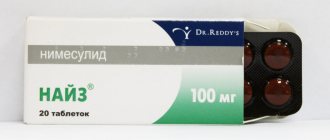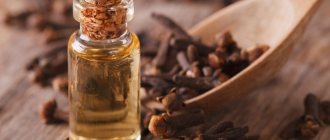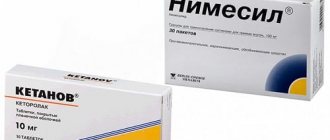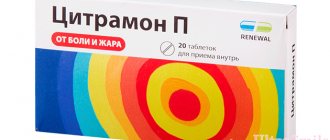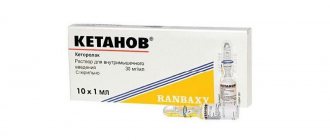Every person experiences pain at least once in their life. The reasons for its occurrence may be different, but the sensation of pain makes it clear that something is wrong in the body. Therefore, you should not ignore the signs of pain and put off solving the problem indefinitely; it is better to immediately seek help from a doctor, this will allow you to determine the causes of the pain. But this does not mean that you need to endure until the doctor finds the problem.
There are a huge number of painkillers that will very quickly relieve the symptoms of pain, but today we will look in detail at the cases in which Spazmalgon helps.
- 2 Indications for use of Spazmalgon
- 3 Recommendations for taking Spazmalgon
3.1 Side effects from taking Spazmalgon
Does Spazmalgon help with toothache?
The drug helps with toothache. Spazmalgon is part of the group of analgesics with a pronounced antispasmodic effect. The medicine has a combined composition and is therefore prescribed for pain syndromes of various origins.
The analgesic effect is provided due to the anti-inflammatory properties of the active ingredients. The substances that make up Spazmalgon reduce the sensitivity of pain receptors. In view of this, the medicine can be used for any acute pain, including dental pain.
How long does it take for the medicine to work?
The action of Spasmalgon develops quite quickly. On average, the tablet is absorbed within 25-40 minutes . The severity of the analgesic effect depends on the intensity of the pain and the dose taken. The effect lasts for an average of 4 hours.
NON-STEROID ANTI-INFLAMMATORY DRUGS IN DENTISTRY
Sologova Diana Igorevna Puntovaya Kristina Dmitrievna Federal State Autonomous Educational Institution of Higher Education “First Moscow State Medical University named after. THEM. Sechenov Ministry of Health of Russia" (Sechenov University)
EFFECTIVENESS OF NSAID USE
In terms of the strength of the analgesic effect, Ketorolac is significantly superior to other NSAIDs. The drug does not depress respiration, does not affect opioid receptors, does not cause drug dependence, and does not have a sedative or anxiolytic effect. It is also important that the drug begins to have an analgesic effect within 15–30 minutes. after reception. The drug is recommended for use as a means of pathogenetic and symptomatic therapy in the conservative and surgical treatment of generalized periodontitis. With its use, earlier relief of pain and signs of local inflammatory reaction (swelling and bleeding of the gums) are recorded. The drug is also capable of reducing the rate of bone tissue resorption, incl. and in the presence of microorganisms, which is a significant factor in favor of including the drug in the pharmacotherapy regimen for periodontitis.
In addition, because Ketorolac has high analgesic activity; it is used as an alternative to narcotic analgesics for moderate or severe pain after surgery in the maxillofacial area.
- Ketoprofen is a powerful non-steroidal anti-inflammatory drug.
It relieves pain well and helps with most of these symptoms, and also relieves inflammation in soft tissues. In addition, ketoprofen helps lower the temperature if it is elevated due to some serious pathology. It is used in the form of a rinse solution - symptomatic treatment of inflammatory diseases of the oral cavity, such as stomatitis, glossitis, gingivitis, periodontitis, periodontal disease, for analgesia during the treatment and extraction of teeth (as an auxiliary drug). Ketoprofen relieves pain quite quickly, but this is not enough. It does not affect the cause of the disease (caries, pulpitis or periodontitis). The main danger of the drug is that a person can suppress the pain for a very long time and not go to the doctor, and this will lead to complications both for dental diseases and for the whole body (possible development of dizziness, lethargy, vomiting, nausea, abdominal pain) .
Ketoprofen in the form of a 1% cream, when applied 1.8 ml once a day for 6 months to the gum area of rhesus monkeys with periodontitis, promoted the restoration of alveolar bone and significantly reduced the levels of PGE2 and LT B4 in the periodontal fluid (after 2 and 3 months of treatment ). The drug in the form of a 2% gel, when applied to the gums of patients with chronic periodontitis in addition to instrumental therapy, contributed to a significant reduction in probing depth.
- Nimesulide . Toothache is not a direct indication for taking this drug.
The drug is used primarily for rheumatic diseases that affect the joints and surrounding tissues. The action of the medicine is aimed at eliminating the symptoms of inflammation, which include pain, incl. and dental. But it must be remembered that the effectiveness of Nimesulide depends on the reason for the toothache. In severe dental pathologies, even potent analgesics cannot eliminate the symptom.
It is effective to use the drug for gingivitis, because it eliminates swelling and helps normalize local temperature. The effect after administration is observed quite quickly; on average, it begins to act within 25–30 minutes. The analgesic effect lasts for a fairly long period of time - up to 10 hours.
Important! The medicine is also characterized by a number of disadvantages: it cannot be used during pregnancy and children; it is not intended for long-term use; there is a possibility of addiction; toxic effects on the liver; potential - overdose and poisoning.
- Ibuprofen inhibits the synthesis of prostaglandins, which, in turn, increase the sensitivity of nociceptive receptors.
Due to this, pain is reduced, but the effect is temporary (lasts up to 12 hours). You can take the drug for toothache, but no more than 5 days in a row.
The administration of Ibuprofen to patients with chronic periodontitis after 14 days was accompanied by a significantly more pronounced reduction in bleeding and hyperemia of the gums, as well as the depth of periodontal pockets compared to the group without pharmacotherapy.
Use of NSAIDs:
- for acute pain resulting from advanced caries or pulpitis;
- before hygienic procedures (removal of hard deposits, bleaching), with an increased pain threshold in the patient;
- to relieve pain that occurs after treatment;
- to eliminate pain during the period of getting used to braces, prosthesis and other structures;
- in inflammatory processes in the soft tissues of the oral cavity (periodontitis, periodontitis, stomatitis).
You should not take NSAIDs if:
- intestinal diseases;
- pregnancy more than 24 weeks;
- liver and kidney failure;
- Do not lie;
- blood clotting disorders;
- recently undergone SS operations.
In order to avoid intoxication and negative effects on the gastric mucosa, it is necessary to take the drug after meals.
NSAIDs. GENERAL CHARACTERISTICS
Nonsteroidal anti-inflammatory drugs (NSAIDs) are a group of medications that are widely used in clinical practice, many of which can be purchased without a prescription. More than thirty million people worldwide take NSAIDs daily, with 40% of these patients over 60 years of age. The great popularity of NSAIDs is explained by the fact that they have anti-inflammatory, analgesic and antipyretic effects and bring relief to patients with corresponding symptoms (inflammation, pain, fever), which are observed in many diseases. The use of the term “non-steroidal” emphasizes their difference from glucocorticoids, which have not only an anti-inflammatory effect, but also other, sometimes undesirable properties of steroids.
Over the past 30 years, the number of NSAIDs has increased significantly, and currently this group includes a large number of drugs that differ in their characteristics of action and use.
More than 60 million packages of Ibuprofen and Ketorolac, more than 25 million packages of Diclofenac, and almost 20 million packages of Nimesulide are sold annually in Russia.
The main mechanism of action of NSAIDs is the suppression of the activity of cyclooxygenase (COX), an enzyme that regulates the conversion of arachidonic acid into prostaglandins (PG), prostacyclin (PG12) and thromboxane (TxAg). The nature of the effect of NSAIDs on the COX isoforms—COX-1 and COX-2—is especially important. COX-1 is constantly present in most tissues (albeit in varying quantities) and belongs to the category of “constitutive” (“structural”) enzymes that regulate the physiological effects of PG. COX-2 plays the role of a “structural” enzyme only in some organs (brain, kidneys, bones, reproductive system in women), and is not normally found in other organs. However, the expression of COX-2 increases significantly under the influence of immune mediators (cytokines) involved in the development of the immune response, inflammation, cell proliferation, etc.
Inhibition of COX-2 is one of the important mechanisms of anti-inflammatory and analgesic activity, and COX-1 of the toxicity of NSAIDs. Non-selective NSAIDs inhibit the activity of both COX isoforms to the same extent and therefore have approximately similar effectiveness. This discovery served as the basis for the creation of a new group of NSAIDs that predominantly inhibit COX-2 (selective COX-2 inhibitors). They have all the positive properties of non-selective NSAIDs, but are less toxic, at least in relation to the gastrointestinal tract. Based on their selectivity of action against COX isoforms, NSAIDs are divided into 4 groups (Table 1).
Table 1 Classification of NSAIDs by selectivity of action on COX isoforms
| Group | Active ingredients |
| Non-selective COX inhibitors | Indomethacin, ibuprofen, diclofenac |
| Selective COX-1 inhibitors | Low doses of acetylsalicylic acid |
| Selective COX-2 inhibitors | Coxibs (celecoxib, rofecoxib, valdecoxib, etc.); Meloxicam, nimesulide, etodolac |
| Selective COX-3 inhibitors | Paracetamol, metamizole sodium |
In addition, NSAIDs are classified depending on the severity of their anti-inflammatory activity and chemical structure. The first group includes drugs with a pronounced anti-inflammatory effect. NSAIDs of the second group, which have a weak anti-inflammatory effect, are often designated by the terms “non-narcotic analgesics” or “analgesics-antipyretics” (Table 2).
Table 2 Classification of NSAIDs depending on the severity of anti-inflammatory activity and chemical structure
| NSAIDs with pronounced anti-inflammatory activity | |
| Acids | |
| Salicylates | Acetylsalicylic acid Diflunisal Lysine monoacetylsalicylate |
| Pyrazolidines | Phenylbutazone |
| Indoleacetic acid derivatives | Indomethacin Sulindac Etodolac |
| Phenylacetic acid derivatives | Diclofenac |
| Oxycams | Piroxicam Tenoxicam Lornoxicam Meloxicam |
| Propionic acid derivatives | Ibuprofen Naproxen Flurbiprofen Ketoprofen Tiaprofenic acid |
| Non-acid derivatives | |
| Alcanons | Nabumethon |
| Sulfonamide derivatives | Nimesulide Celecoxib Rofecoxib |
| NSAIDs with weak anti-inflammatory activity | |
| Anthranilic acid derivatives | Mefenamic acid Etofenamate |
| Pyrazolones | Metamizole Aminophenazone Propyphenazone |
| Para-aminophenol derivatives | Phenacetin Paracetamol |
| Heteroarylacetic acid derivatives | Ketorolac |
NSAIDS IN DENTISTRY
According to Orenburg State University, the list of the most commonly used non-steroidal anti-inflammatory drugs in dental practice in tablet form as of 2015 was as follows (Fig.):
- Ketoprofen - prescription frequency 56%, duration of action 6 hours.
- Ketorolac - prescription frequency 20%, duration of action 4-5 hours.
- Nimesulide - prescription frequency 14%, duration of action 5 hours.
- Ibuprofen - prescription frequency 8%, duration of action 4 hours.
- Metamizole sodium - prescription frequency 2%, duration of action 4 hours.
Rice.
In dental practice, NSAIDs are widely used for inflammatory diseases of the maxillofacial region and oral mucosa, inflammatory swelling after injuries, operations, pain syndrome, arthrosis and arthritis of the temporomandibular joint, myofascial pain syndrome of the maxillofacial region, neuritis, neuralgia, postoperative pain, feverish conditions.
Compound
Spasmalgon is a combination drug.
The composition includes the following components:
- Metamizole sodium. A substance with anti-inflammatory properties of the non-steroidal group. It is characterized by a pronounced analgesic and anti-inflammatory effect. The component prevents the secretion of substances responsible for the formation of the inflammatory response, which in turn leads to a decrease in pain sensitivity in the affected area.
- Pitophenone hydrochloride. Antispasmodic component of the drug. The substance reduces smooth muscle tone. This helps relieve pain caused by spasms.
- Phenpiverinium bromide. It is an anticholinergic substance that has an antispasmodic effect. The component helps relax smooth muscles, thereby enhancing the analgesic effect.
The described components interact with each other, thereby enhancing the effect, which will help with toothache and also relieve pain after tooth extraction. Auxiliary components include gelatin, starch, magnesium stearate.
Composition of drugs, its effects and release form
The effectiveness of the drug is ensured by the combined composition. The main effects of taking the drug spasmalgon, the instructions for use indicate this, are a pronounced analgesic and antispasmodic effect. Additionally, the medicine lowers body temperature. You need to know what spasmalgon helps with in order to use it correctly.
The peculiarity of the effects of using the product is associated with the following properties of the main components:
- Metamizole sodium effectively relieves pain, lowers body temperature and reduces inflammation.
- Pitophenone hydrochloride has a direct myotropic effect, providing an antispasmodic and vasodilating effect, which helps relieve discomfort.
- Enhances the relaxing effect of the drug fenpiverinium bromide, which belongs to the group of M-anticholinergics.
A special feature of spasmalgon is the high speed of obtaining results. When taking tablets or performing an injection, it is possible to relieve pain in no more than 40 minutes. The number of main components differs in different forms.
You can purchase spasmalgon, which has a combined composition, in a cardboard box in two forms:
- Tablets in blisters.
- Ampoules for injection.
Indications for toothache
The use of Spazmalgon is advisable for a wide range of pathological phenomena accompanied by toothache.
Indications include:
- Increased sensitivity of teeth (due to violation of the integrity of the enamel)
- Formation of carious lesions
- Development of pulpitis against the background of caries
- Periodontal inflammation
- Infectious lesions of the periosteum
- Trigeminal nerve lesions
- Jaw injuries accompanied by toothache
Important to remember! Spazmalgon is used as an emergency remedy to relieve toothache. The medicine does not provide a long-term analgesic effect, since it does not relieve the cause of the pain syndrome.
Instructions for use
Spazmalgon is also available in ampoule format.
Taking any medications, especially analgesics, should be carried out in accordance with the instructions.
Detailed instructions are included with the medicine. Before taking it, it is important to make sure there are no contraindications or other possible restrictions.
Rules for taking Spazmalgon:
- If acute toothache occurs, take 1 or 2 tablets
- Tablets are taken orally
- The medicine should be taken with a sufficient amount of water
- It is forbidden to chew or dissolve Spazmalgon in the mouth.
Reference! If the patient is unable to fully take the medicine in tablet form, it can be replaced with an analogue in the form of an injection solution.
Dosage
To eliminate toothache, it is enough to take 1 or 2 tablets. The dosage is prescribed in accordance with the intensity of the pain syndrome and the suspected cause of its occurrence. For severe toothaches, it is recommended to take 2 tablets to completely get rid of the disease.
During the day, the patient is allowed to take no more than 6 Spazmalgon tablets. Thus, let's take 2 tablets three times a day. Between each dose there should be approximately the same time period.
With intense inflammation, the effectiveness of the described medicine may decrease. In this case, you should immediately seek dental care.
Important! Spazmalgon is not intended for long-term use. It is recommended to take the medicine no longer than 3 days. Otherwise, the risk of side effects increases.
Indications for use of Spazmalgon
The drug is released in the form:
- white, round tablets;
- solution for injection.
Spazmalgon is recommended to be taken for moderate pain , which can be caused by various factors.
In what cases can Spazmolgon be used:
- During menstruation. The drug is used for pain relief in the form of tablets. Two tablets per day are enough to relieve pain, but the interval between doses should not be less than 4 hours.
- Diseases of the stomach and intestines . Spasmalgon is an excellent remedy for eliminating pain in the stomach and intestines, since spasm of smooth muscles goes away after taking the medicine. The product also effectively relieves pain in ailments such as urolithiasis and exacerbation of biliary dyskinesia.
- Diseases of the genitourinary system and cystitis. The medicine contains fenpiverinium bromide, which helps reduce pain during inflammatory processes of the genitourinary system.
- Problems of the musculoskeletal system. For diseases such as arthrosis, neuralgia, osteochondrosis and others, it is recommended to use the drug intramuscularly, but the medicine should not be used for more than three days in a row.
- Temperature increase . Spasmolgon is able to normalize body temperature if its increase was caused by inflammation. If the temperature has increased due to a psychosomatic condition, such therapy will not give the expected effect.
Contraindications
More advantageous packaging – 50 Spazmalgon tablets.
Absolute contraindications include the following:
- Individual hypersensitivity
- Intestinal obstruction
- Functional gallbladder disorders
- Kidney or liver failure
- Pregnancy and lactation
- Leukopenia
- Anemia
- Severe respiratory tract diseases
- Cardiac disorders (arrhythmias, tachycardia)
- Age limit (children under 5 years old)
The drug is not recommended if the pain syndrome is of unknown origin and can be caused by serious illnesses requiring urgent surgical intervention.
The simultaneous use of Spazmalgon and any alcoholic beverages, sedatives, or medications containing Metamizole is strictly prohibited.
Contraindications to taking Spazmolgon
- The presence of surgical pathologies that require surgical intervention.
- Intestinal obstruction.
- Low blood pressure (hypotension).
- Failure is both renal and liver.
- Poor hematopoiesis, occurring with disturbances.
- Prostate adenoma, which is associated with urinary problems.
- Pregnancy, especially the first and third trimesters, as well as lactation.
- Severe disturbances in the functioning of the liver and bile ducts.
- Tachycardia, glaucoma, etc.
It should be remembered that should be used very carefully in patients who have bronchial asthma or other allergic diseases. In some cases, an exacerbation of the disease may occur.
Admission in childhood
In the form of tablets, Spazmalgon is allowed to be taken by children over 5 years old. The dosage regimen depends on the age of the child.
Method of administration in childhood:
- From 5 to 9 years – 1 tablet 2 times a day
- From 9 to 12 years – 1 tablet 3 times a day
- From 12 to 13 years – 1 tablet up to 4 times a day
- From 13 years – 1-2 tablets up to 6 tablets per day
It is recommended to consult a pediatrician before use. The duration of therapy should not be longer than 3 days. At least 6 hours should pass between each dose.
Use during pregnancy
During the period of bearing a child, taking Spazmalgon is prohibited. The drug is considered most dangerous in the 1st trimester, as it can provoke abnormalities in the development of internal organs.
Clinical studies refuting or confirming harm to the fetus in the 2nd and 3rd trimester have not been conducted. Taking Spazmalgon is not recommended during breastfeeding. The active components are characterized by increased penetrating ability, as a result of which they can enter the baby’s body through breast milk.
If necessary, when taking Spazmalgon, lactation is interrupted. Feeding may be resumed 48 hours after the last pill intake.
Advantages and disadvantages
Spazmalgon is characterized by the following advantages:
- Convenient release form
- Pronounced analgesic effect
- Long lasting
- Possibility of repeated admission within 3 days
- Possibility of admission in childhood
- Highly effective for pain syndromes of various origins
Unfortunately, despite the large number of advantages, the medicine has a number of disadvantages. The most significant include a wide range of contraindications, which is why not all patients can use this medicine. In addition, taking the medication can cause unpleasant side effects.
These include:
- Heartburn
- Dry mouth
- Nausea and vomiting
- Dizziness
- Shortness of breath
- Tachycardia
- Change in urine color
- Allergic skin rashes
- Anaphylactic reactions
The potential for side effects indicates the need for strict adherence to dosages and timing of administration.
Is it harmful to take spasmalgon for toothache?
Like other drugs, spasmalgon can cause side effects if its components are intolerant, there are a number of pathologies, or if the optimal dosage regimen is violated. Using this medicine may cause the following unwanted effects:
- From the digestive system – a feeling of dry mouth. In more severe cases - abdominal pain, nausea and vomiting. Exacerbation of gastrointestinal diseases is also possible.
- On the skin side - signs of an allergic reaction, such as itching and rashes.
- From the cardiovascular system - hypertension and heart rhythm disturbances.
- From the nervous system - dizziness, headaches, fatigue, irritability.
- From the genitourinary system - frequent, or, on the contrary, too infrequent urination. In severe cases - acute nephritis and impaired renal function.
In some cases, after taking spasmalgon, urine turns red. However, this phenomenon should not be considered as a pathology.
Metamizole, contained in spasmalgon, can cause a sharp decrease in the level of leukocytes in the blood, which means a drop in the body's resistance to infections. However, this phenomenon occurs very rarely.
All of the above undesirable consequences of using spasmalgon occur either when the drug is used for too long, or when intravenous injections of the drug are used. When taking tablets of this medication orally, negative reactions occur extremely rarely.
When is it unacceptable to take spasmalgon for toothache?
In case of a number of pathologies of the body, spasmalgon cannot be used. Contraindications to this medicine include the following disorders:
- various pathologies requiring surgical treatment;
- intestinal obstruction;
- drop in blood pressure;
- dysfunction of the kidneys and liver, as well as pathologies of the bile duct;
- disturbance of blood formation;
- prostate adenoma, causing urination problems;
- heart rhythm disturbances;
- glaucoma;
- bronchial asthma;
- tendency to allergic reactions.
In addition, spasmalgon should not be used during pregnancy. Its use is especially undesirable in the first and third trimester. The drug is also contraindicated during breastfeeding.
If, when using any non-steroidal anti-inflammatory drug in the past, signs of allergies, bronchospasm and the formation of nasal polyps were simultaneously observed, then spasmalgon should not be taken either. Such a reaction means a general intolerance to all drugs related to non-steroidal anti-inflammatory drugs.
Cost and analogues
The price of the drug Spazmalgon varies depending on the manufacturer and the number of tablets in the package. The cost of a package of 10 tablets is 136 rubles . The price for 20 tablets is from 144 rubles , and for 50 tablets – from 300 rubles .
If necessary, Spazmalgon can be replaced with a drug with a similar effect. The most popular analogues are presented in the table.
| Name | Price | Short description |
| Spazgan | 249 rubles per pack of 100 tablets | It is a direct analogue of Spasmalgon. Has identical active ingredients. It is used for various pain syndromes, including to eliminate toothache. |
| Took | 51 rubles per pack of 10 tablets | Antispasmodic based on Metamizole in combination with Pitophenone hydrochloride and fenpiverinium. It has a pronounced analgesic, antipyretic and anti-inflammatory effect. |
| Maxigan | 326 rubles per pack of 100 tablets | Antispasmodic drug with similar active ingredients. It is used for dental headaches, syndromes caused by inflammatory processes in tissues, rheumatism, injuries, postoperative pain. |
| Spasmalin | 118 rubles per pack of 20 tablets | Direct analogue of Spazmalgon. Has pronounced analgesic activity. Allowed to take up to 4 times a day. |
| Spasmoblock | 105 rubles per pack of 20 tablets | Prescribed to relieve pain caused by smooth muscle spasms and inflammatory processes. It is advisable to take for mild or moderate syndromes. |
Reviews
In this section you can read user reviews about the drug Spazmalgon, the advantages and disadvantages of taking the presented drug, and effective analogues.
Spasmalgon is a potent combination drug that has a pronounced analgesic effect. The drug is prescribed to eliminate pain of various origins, including toothache. Administration must be carried out in full accordance with the prescribed dosages, taking into account the patient’s age, pain intensity, and possible contraindications.
